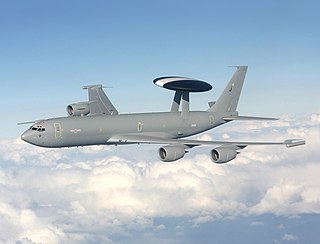
An airborne early warning and control (AEW&C) system is an airborne radar early warning system designed to detect aircraft, ships, vehicles, missiles and other incoming projectiles at long ranges, as well as performing command and control of the battlespace in aerial engagements by informing and directing friendly fighter and attack aircraft. AEW&C units are also used to carry out aerial surveillance over ground and maritime targets, and frequently perform battle management command and control (BMC2). When used at altitude, the radar system on AEW&C aircraft allows the operators to detect, track and prioritize targets and identify friendly aircraft from hostile ones in real-time and from much farther away than ground-based radars. Like ground-based radars, AEW&C systems can be detected and targeted by opposing forces, but due to aircraft mobility and extended sensor range, they are much less vulnerable to counter-attacks than ground systems.

The fourth-generation fighter is a class of jet fighters in service from around 1980 to the present, and represents design concepts of the 1970s. Fourth-generation designs are heavily influenced by lessons learned from the previous generation of combat aircraft. Third-generation fighters were often designed primarily as interceptors, being built around speed and air-to-air missiles. While exceptionally fast in a straight line, many third-generation fighters severely lacked in maneuverability, as doctrine held that traditional dogfighting would be impossible at supersonic speeds. In practice, air-to-air missiles of the time, despite being responsible for the vast majority of air-to-air victories, were relatively unreliable, and combat would quickly become subsonic and close-range. This would leave third-generation fighters vulnerable and ill-equipped, renewing an interest in manoeuvrability for the fourth generation of fighters. Meanwhile, the growing costs of military aircraft in general and the demonstrated success of aircraft such as the McDonnell Douglas F-4 Phantom II gave rise to the popularity of multirole combat aircraft in parallel with the advances marking the so-called fourth generation.
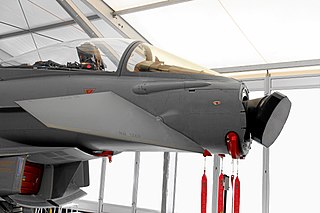
An active electronically scanned array (AESA) is a type of phased array antenna, which is a computer-controlled antenna array in which the beam of radio waves can be electronically steered to point in different directions without moving the antenna. In the AESA, each antenna element is connected to a small solid-state transmit/receive module (TRM) under the control of a computer, which performs the functions of a transmitter and/or receiver for the antenna. This contrasts with a passive electronically scanned array (PESA), in which all the antenna elements are connected to a single transmitter and/or receiver through phase shifters under the control of the computer. AESA's main use is in radar, and these are known as active phased array radar (APAR).

The Erieye radar system is an Airborne Early Warning and Control System (AEW&C) developed by Saab Electronic Defence Systems of Sweden. It uses active electronically scanned array (AESA) technology. The Erieye is used on a variety of aircraft platforms, such as the Saab 340 and Embraer R-99. It has recently been implemented on the Bombardier Global 6000 aircraft as the GlobalEye.

The AN/APG-63 and AN/APG-70 are a family of all-weather multimode radar systems designed by Hughes Aircraft for the F-15 Eagle air superiority fighter. These X band pulse-Doppler radar systems are designed for both air-air and air-ground missions; they are able to look up at high-flying targets and down at low-flying targets without being confused by ground clutter. The systems can detect and track aircraft and small high-speed targets at distances beyond visual range down to close range, and at altitudes down to treetop level. The radar feeds target information into the aircraft's central computer for effective weapons delivery. For close-in dogfights, the radar automatically acquires enemy aircraft and projects this information onto the cockpit head-up display. The name is assigned from the Army Navy Joint Electronics Type Designation System.
The AN/APG-65 and AN/APG-73 are designations for a family of all-weather multimode airborne radar systems designed by Hughes Aircraft for the F/A-18 Hornet, and used on a variety of fighter aircraft types. The APG-79 is an upgraded AESA version.

The EL/M-2075 Phalcon is an airborne early warning and control (AEW&C) active electronically scanned array radar system developed by Israel Aerospace Industries (IAI) and Elta Electronics Industries of Israel. Its primary objective is to provide intelligence to maintain air superiority and conduct surveillance. It was surpassed by newer versions—the EL/W-2085 and the EL/W-2090.
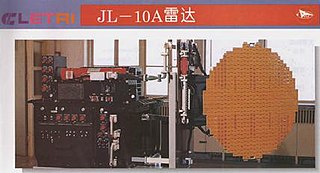
The JL-10A airborne radar is a highly digitized pulse-Doppler radar with slotted planar array developed for the People's Liberation Army Air Force (PLAAF) as a replacement for the older Type 232H radar currently employed by the Chinese air force. The radar is built to MIL-STD-1553 standard so it is compatible with western electronics and weaponry. Originally, the radar is capable of simultaneously tracking 10 targets and engaging 2 of the 10 tracked when using semi-active radar homing air-to-air missiles, or 4 of the 10 tracked when using active radar homing air-to-air missiles.

The KJ-2000 is a Chinese second-generation airborne early warning and control (AEW&C) aircraft developed by the Shaanxi Aircraft Corporation, and is the first AEW&C system in service to the People's Liberation Army Air Force. It is built upon a modified Russian Ilyushin Il-76 airframe using domestically designed avionics and a fixed radome featuring three active electronically scanned array (AESA) radars each covering a 120-degree sector, unlike the rotating radome on the comparable E-3 Sentry serving the United States Air Force.
The PS-05/A is a pulse-doppler radar currently used by the JAS 39 Gripen fighter aircraft. It weighs 156 kg and was developed by Ericsson in collaboration with GEC-Marconi, sharing some technology with the latter's Blue Vixen radar for the Sea Harrier.
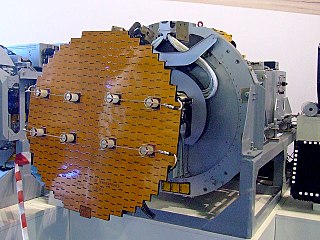
The Zhuk are a family of Russian all-weather multimode airborne radars developed by NIIR Phazotron for multi-role combat aircraft such as the MiG-29 and the Su-27. The PESA versions were also known as the Sokol.
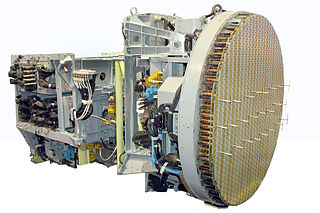
The Bars (Leopard) is a family of Russian all-weather multimode airborne radars developed by the Tikhomirov Scientific Research Institute of Instrument Design for multi-role combat aircraft such as the Su-27, Su-30 and the MiG-29.
Electronics and Radar Development Establishment (LRDE) is a laboratory of the Defence Research & Development Organisation (DRDO), India. Located in C.V. Raman Nagar, Bengaluru, Karnataka, its primary function is research and development of radars and related technologies. It was founded by S. P. Chakravarti, the father of Electronics and Telecommunication engineering in India, who also founded DLRL and DRDL.
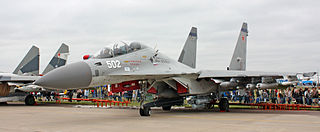
N001 Mech is a Russian all-weather multimode airborne radar developed by the Tikhomirov Scientific Research Institute of Instrument Design (NIIP) for the Su-27 multi-role combat aircraft.

The DRDO Airborne Early Warning and Control System (AEW&CS) is a project of India's Defence Research and Development Organisation to develop an airborne early warning and control system for the Indian Air Force. It is also referred to as NETRA Airborne Early Warning and Control System (AEW&CS).

The EL/W-2085 is an airborne early warning and control (AEW&C) multi-band radar system developed by Israel Aerospace Industries (IAI) and Elta Electronics Industries of Israel. Its primary objective is to provide intelligence to maintain air superiority and conduct surveillance. The system is currently in-service with Israel, Italy, and Singapore.

EL/M-2106 ATAR is a solid state L band medium range tactical 3D radar with active electronically scanned array (AESA) in elevation.

The IAI EL/W-2090 is an airborne early warning and control (AEW&C) radar system developed by Israel Aerospace Industries (IAI) and Elta Electronics Industries of Israel. Its primary objective is to provide intelligence to maintain air superiority and conduct surveillance. The system is currently in-service with the Indian Air Force.
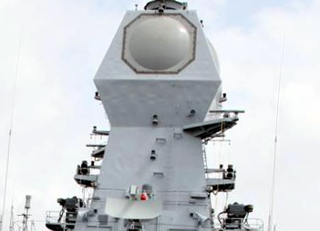
The EL/M-2248 MF-STAR is a multifunction active electronically scanned array naval radar system developed by IAI Elta for maritime installation on warships. It is capable of tracking both air and surface targets and providing fire control guidance. MF-STAR is an acronym of Multi-Function Surveillance, Track And Guidance Radar.

Uttam is a solid-state gallium arsenide (GaAs) based active electronically scanned array (AESA) radar under development by the Electronics and Radar Development Establishment (LRDE), a laboratory of the Indian Defence Research and Development Organisation (DRDO). It is a low probability of intercept radar. It is a liquid cooled AESA radar featuring quad band modules that can be stacked to form a larger unit. This allows the manufacturer to scale the radar to be used in larger aircraft.
















